Locating Bass on Structure – Lake Havasu
The fact that Lake Conroe lacks vast amounts of aquatic vegetation requires us to extensively use our electronics to find fish. Fish live on structure, therefore, we fish structure whether it be dropoffs, creek channels, roadbeds, pond dams, humps, rocks, or standing timber; these are the areas that you will find concentrations of fish.
Taking into consideration that most of these structures are underwater and are not visible from the surface means that to locate them and fish them effectively a graph is a necessity. The graph is a very crucial tool when fishing Lake Conroe. This is the only “window” that you have to figure out what is going on underwater.
Understanding how the graph works and what you are looking at when you view the screen is one of the most important attributes to using the graph to your advantage. The unit(graph) has a transducer that is mounted somewhere in the hull or off of the transom. The transducer is what sends out a beam and receives back the information that is relayed to the unit. The beam is the shape of a cone and anything that comes into the cone appears on the screen of the graph. To get a better understanding of this completely forget about water for a minute. Picture yourself standing in a field at night, it is pitch dark. Now picture a helicopter hovering at twenty feet above the ground just out in front of you. The helicopter has a Q-Beam pointed at the ground and the only thing that you can see is what comes into the beam of the light. This is exactly like what happens on the water when you graph the bottom. Your boat is like the helicopter and the transducer shooting beam from the boat is similar to the beam of the Q-Beam from the helicopter.
Also the information is put on the screen as if you were looking at from the side. What goes on the screen of the graph is a profile of the cone(beam).
To get the most accurate reading when locating fish program the unit in the manual mode. This will dis-enable the unit to put the little fish symbols in where the unit “thinks” that there is a fish. Fish will show up as inverted V’s. The longer the taper from the inverted V the bigger the fish. Also the size of the inverted V is an indication of the size of the fish. Bait fish in large school will show up as a cloud or ball on the screen. Individual or small schools of bait will show up as specks or small dark areas on the screen.
Finding underwater structure is the key to catching fish on Lake Conroe and a good understanding of the graph will make you more successful. For more information or a guide trip booking call me at (281) 380 8222. Good luck fishing.
Bill Cannan – Professional Fishing Guide – Lake Havasu
Read More









